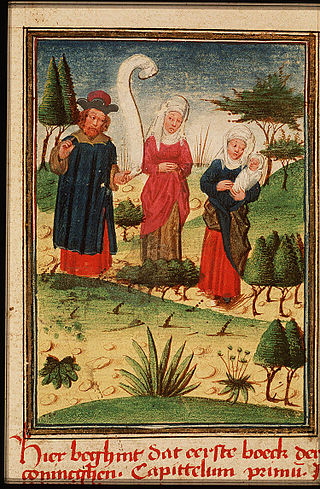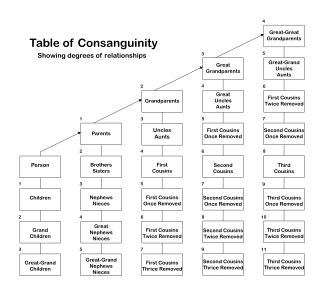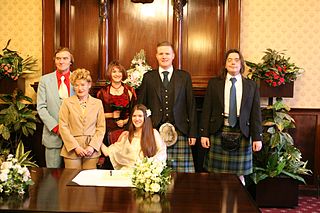
In a culture where only monogamous relationships are legally recognized, bigamy is the act of entering into a marriage with one person while still legally married to another. A legal or de facto separation of the couple does not alter their marital status as married persons. In the case of a person in the process of divorcing their spouse, that person is taken to be legally married until such time as the divorce becomes final or absolute under the law of the relevant jurisdiction. Bigamy laws do not apply to couples in a de facto or cohabitation relationship, or that enter such relationships when one is legally married. If the prior marriage is for any reason void, the couple is not married, and hence each party is free to marry another without falling foul of the bigamy laws.

Consanguinity is the characteristic of having a kinship with a relative who is descended from a common ancestor.

In Catholic canon law, affinity is an impediment to marriage of a couple due to the relationship which either party has as a result of a kinship relationship created by another marriage or as a result of extramarital intercourse. The relationships that give rise to the impediment have varied over time. Marriages and sexual relations between people in an affinity relationship are regarded as incest.
Jewish views on incest deal with the sexual relationships which are prohibited by Judaism and rabbinic authorities on account of a close family relationship that exists between persons. Such prohibited relationships are commonly referred to as incest or incestuous, though that term does not appear in the biblical and rabbinic sources. The term mostly used by rabbinic sources is "forbidden relationships in Judaism".

Dower is a provision accorded traditionally by a husband or his family, to a wife for her support should she become widowed. It was settled on the bride by agreement at the time of the wedding, or as provided by law.
In law and in cultural anthropology, affinity is the kinship relationship created or that exists between two people as a result of someone's marriage. It is the relationship each party in the marriage has to the family of the other party in the marriage. It does not cover the marital relationship itself. Laws, traditions and customs relating to affinity vary considerably, sometimes ceasing with the death of one of the marriage partners through whom affinity is traced, and sometimes with the divorce of the marriage partners. In addition to kinship by marriage, "affinity" can sometimes also include kinship by adoption or a step relationship.

Marriage is available in England and Wales to both opposite-sex and same-sex couples and is legally recognised in the forms of both civil and religious marriage. Marriage laws have historically evolved separately from marriage laws in other jurisdictions in the United Kingdom. There is a distinction between religious marriages, conducted by an authorised religious celebrant, and civil marriages, conducted by a state registrar. The legal minimum age to enter into a marriage in England and Wales is 18 since 27 February 2023. Previously the minimum age of marriage was 16, with parental permission. This also applies to civil partnerships.

Marriage law is the legal requirements, an aspect of family law, that determine the validity of a marriage, and which vary considerably among countries.
A cousin marriage is a marriage where the spouses are cousins. The practice was common in earlier times and continues to be common in some societies today, though in some jurisdictions such marriages are prohibited. Worldwide, more than 10% of marriages are between first or second cousins. Cousin marriage is an important topic in anthropology and alliance theory.
In law, a prohibited degree of kinship refers to a degree of consanguinity, or sometimes affinity between persons that makes sex or marriage between them illegal.

This article summarizes the same-sex marriage laws of states in the United States. Via the case Obergefell v. Hodges on June 26, 2015, the Supreme Court of the United States legalized same-sex marriage in a decision that applies nationwide, with the exception of American Samoa and sovereign tribal nations.
A void marriage is a marriage that is unlawful or invalid under the laws of the jurisdiction where it is entered. A void marriage is invalid from its beginning, and is generally treated under the law as if it never existed and requires no formal action to terminate. In some jurisdictions a void marriage must still be terminated by annulment, or an annulment may be required to remove any legal impediment to a subsequent marriage. A marriage that is entered into in good faith, but that is later found to be void, may be recognized as a putative marriage and the spouses as putative spouses, with certain rights granted by statute or common law, notwithstanding that the marriage itself is void.

The Regency Act 1830 was an Act of the Parliament of the United Kingdom passed to provide for the event that King William IV died while the next person in line to the throne was not yet aged 18. It provided for a regency until the new monarch reached the age of 18, and also would have enabled a posthumous child of King William IV to replace Queen Victoria on the throne. However, the Act never came into force, because William was not survived by a legitimate child, and Victoria became queen in 1837 a few weeks after turning 18.

Family law in Canada concerns the body of Canadian law dealing with domestic partnerships, marriage, and divorce.

Marriage in Scotland is recognised in the form of both civil and religious unions between individuals. Historically, the law of marriage has developed differently in Scotland to other jurisdictions in the United Kingdom as a consequence of the differences in Scots law and role of the separate established Church of Scotland. These differences led to a tradition of couples from England and Wales eloping to Scotland, most famously to marry at border towns such as Gretna Green. The legal minimum age to enter into a marriage in Scotland is sixteen years and does not require parental consent at any age.

Polygamous marriages may not be performed in the United Kingdom, and if a polygamous marriage is performed, the already-married person may be guilty of the crime of bigamy under section 11 of the Matrimonial Causes Act 1973.
A sibling-in-law is the spouse of one's sibling, the sibling of one's spouse or the person who is married to the sibling of one's spouse.

The Marriage Act 1949 is an Act of the Parliament of the United Kingdom regulating marriages in England and Wales.

Marriage in New Zealand is governed by an Act of Parliament. The minimum marriage age is 18 years, or 16 years with consent of the Family Court. Polygamous marriages are not permitted in New Zealand. There are prohibitions of marriages between some relatives and some who are already in a civil union.
In English law, restitution of conjugal rights was an action in the ecclesiastical courts and later in the Court for Divorce and Matrimonial Causes. It was one of the actions relating to marriage, over which the ecclesiastical courts formerly had jurisdiction.













